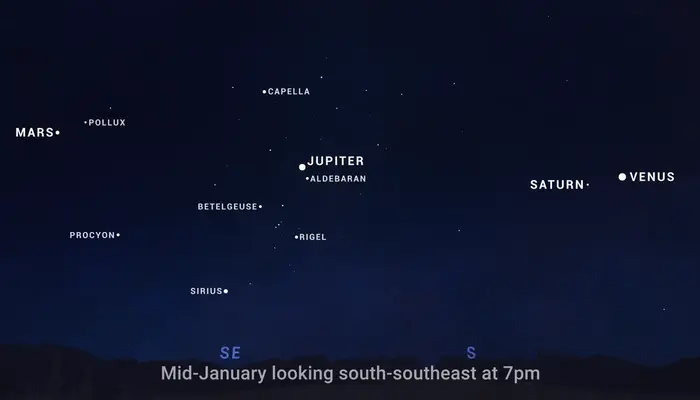In January, stargazers have a rare opportunity to witness a spectacular “planetary parade” in the night sky. Venus, Mars, Jupiter, and Saturn will shine brightly, making their way across the heavens in what NASA calls a must-see event for skywatchers. This alignment of four planets offers a captivating display for anyone looking to explore the wonders of the universe from Earth.
A Rare Alignment of Four Planets
Throughout January 2025, Venus, Mars, Jupiter, and Saturn will be visible in the night sky, each offering a unique show. These planets will line up across the sky, creating a breathtaking sight. While planetary alignments like this don’t happen every year, it’s worth noting that planets often appear along a line called the ecliptic. This line represents the plane in which the planets orbit the Sun.
Preston Dyches, from NASA’s Jet Propulsion Laboratory, explained that this planetary parade is a rare event that shouldn’t be missed. According to Dyches, although such alignments are not extremely rare, they don’t occur every year, making it an exciting spectacle to witness.
Best Viewing Times for Each Planet
Each of the four planets will be visible at different times of the evening. Saturn and Venus will shine in the southwestern sky right after sunset, remaining visible for the first few hours of the night. Jupiter, on the other hand, will dominate the sky overhead, shining bright all night long. Mars will rise in the eastern sky later in the evening, presenting its distinctive red glow that is especially noticeable through telescopes and binoculars.
A Special Conjunction: Venus and Saturn
One of the highlights of this month’s planetary parade will be the close approach of Venus and Saturn. On January 17 and 18, these two planets will appear exceptionally close in what is called a planetary conjunction. This event offers a unique chance to see both planets shining side by side in the night sky.
Dyches also notes that while Venus and Saturn will be the closest during their conjunction, the entire planetary alignment will still provide an exciting opportunity for skywatchers to observe the planets in a sweeping view.
Read: Samsung Galaxy S25 Slim Leak Reveals Key Features
Why the Planets Appear to Line Up
The reason the planets seem to line up in the sky is due to their positions relative to Earth. Because the planets all orbit the Sun in roughly the same plane, they can appear to be close together from our perspective. This alignment of four bright planets offers an unforgettable sight, especially when viewed with binoculars or a telescope.
Other Planets in the Sky
While Venus, Mars, Jupiter, and Saturn will steal the spotlight this month, other planets such as Uranus and Neptune are also present in the night sky. However, these gas giants do not shine as brightly, so you will need a telescope to spot them. Despite being part of our solar system, their faint appearance makes them less noticeable to the naked eye.
Gear Up for the Viewing
To fully appreciate this planetary parade, a telescope or binoculars can enhance the experience. For those interested in astrophotography or a closer look, tools like the Celestron StarSense Explorer 130AZ telescope are recommended. These devices provide clear, detailed views of the planets, making it easier to enjoy the show.
This January, don’t miss the chance to witness a stunning planetary parade. With Venus, Mars, Jupiter, and Saturn visible in the night sky, it’s a celestial event you won’t want to miss.
Follow us on Google News, Instagram, YouTube, Facebook,Whats App, and TikTok for latest updates
